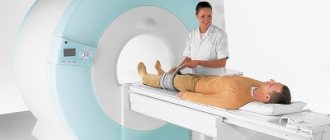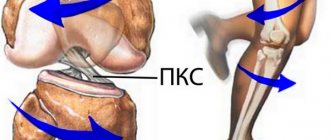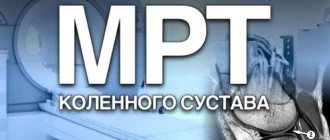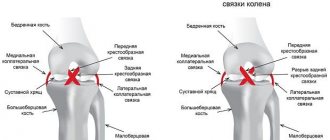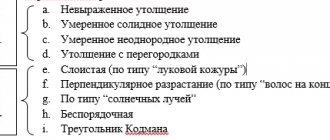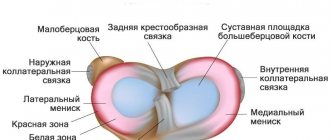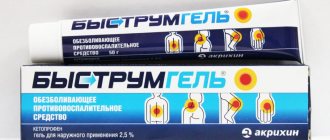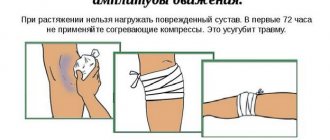Causes of collateral ligament rupture
Isolated rupture of the lateral collateral ligament is extremely rare due to anatomical features and other typical mechanics of injuries. Typically, when the lateral collateral ligament is torn, the traumatic force is so great that it damages the so-called posterolateral complex, which includes the lateral collateral ligament, the popliteus tendon, and the posterolateral capsule of the knee. joint Although such injuries are, fortunately, rare, they occur among young patients when engaging in active sports associated primarily with the active use of the entire range of motion of the knee joint. Among these sports are game types: football, basketball, volleyball; extreme sports: alpine skiing, skydiving, parkour, bike trials and the like.
A rupture of the lateral collateral ligament or damage to the entire posterolateral complex cannot be overlooked. It is accompanied by a noticeable “click” or “crunch”, acute pain and limited ability to support. After some time, significant swelling occurs in the entire area of the injured knee joint.
First aid for a torn collateral ligament of the knee
If the ligaments are damaged, they should be treated using the PLFP method. It is deciphered as follows:
- R - rest.
- L - ice.
- F - fixation.
- P - mark.
If your knee is injured, stop straining it as soon as possible and allow the injured area to rest completely. Then place ice or another cool object on your knee. If ice is used, it is better to wrap it in a towel or clean cloth beforehand. To prevent swelling, you need to apply a tight bandage to the knee joint. This could be a bandage or gauze. The injured leg should always be elevated above the body position.
Even if the pain begins to decrease, the person should still consult a doctor.
Treatment of the lateral ligament of the knee joint
First aid should be provided immediately, and it will consist of strictly limiting the load, elevated position of the injured lower limb, cooling the injury site and promptly transporting the victim to a specialized medical facility. An orthopedic traumatologist, having examined the injured knee joint, will prescribe x-rays and, if a fracture of the lateral (outer) plateau (condyle) of the tibia is not confirmed, an MRI (magnetic resonance imaging) examination of the knee joint will be additionally recommended. A favorable treatment outcome largely depends on the quality and speed of diagnosis. Examination and consultation on treatment tactics should be carried out by a competent doctor with significant experience, because isolated injuries to the lateral (outer) complex are relatively rare, and it is necessary to carefully evaluate all structures of the knee joint for their combined damage.
Based on the number of damaged structures of the knee joint, treatment tactics are determined. A tear of the lateral collateral ligament cannot be treated without surgery, unlike, for example, a tear of the medial collateral ligament. This is ensured by the distance of the lateral collateral ligament from the soft tissues of the joint and its greater isolation.
Surgery for damage to the collateral ligament
When planning surgical intervention, it is essential to take into account concomitant injuries to the knee joint. Most often, arthroscopic exploration of the knee joint is required to suture or remove the damaged part of the meniscus, to repair the anterior or posterior cruciate ligament, or to visualize damage to the popliteus tendon.
After performing all the necessary intra-articular manipulations, a competent orthopedic traumatologist surgeon begins restoration (plasty) of the lateral collateral ligament of the knee joint. It is performed using an autograft (the patient's own tendons) to replace the damaged ligament. The autograft is prepared in a special way and carried through bone canals. This ensures repetition of the anatomy and restoration of function of the knee joint. Of course, in the postoperative period one cannot fail to note the importance of rehabilitation therapy to restore full range of motion and adequate muscle tone. After the end of the recovery period, the patient can return to his usual sports activities, practically without restrictions. In modern surgery, biocompatible and biodegradable clamps are used, which improves the quality of subsequent MRI studies and the quality of diagnosis (even modern metal clamps, despite the possibility of performing MRI studies with them, give very strong interference to the magnetic signal of the tomograph).
Conservative treatment of the lateral and collateral ligaments of the knee
If the rupture of the lateral collateral ligament is partial, then conservative treatment is acceptable, however, the decision on one or another treatment tactic should be made by an experienced and knowledgeable trauma surgeon. Conservative treatment consists of immobilization of the knee joint in a comfortable straight orthosis (not a plaster splint!), which protects the knee joint from unwanted movements in the first time after injury. Therapy aimed at reducing the likelihood of developing deep vein thrombosis of the lower extremities should be recommended. This prevention includes wearing compression hosiery, observing the load regimen and position of the lower limb, as well as taking special antiplatelet drugs. The duration of immobilization is determined individually depending on the degree of injury, but on average it is 4-6 weeks from the moment of injury. After a course of rehabilitation therapy, the patient can begin playing sports in full, protecting the knee joint with a special orthosis (knee brace), which allows flexion and extension of the knee joint, protecting the external collateral ligament of the knee joint from overload.
Very rarely, the lateral collateral ligament is damaged and its attachment to the head of the fibula is separated. In this case, everything depends on the size of the bone fragment of the lateral collateral ligament attachment and the degree of its displacement. If the bone fragment is small and/or its displacement is significant, surgical treatment is recommended. If the bone fragment is large and slightly displaced, then it is permissible to apply conservative treatment.
It should be noted that in the area of the head of the fibula, which is the distal (far) point of attachment of the lateral collateral ligament of the knee, there passes the common peroneal nerve, the importance of which is difficult to overestimate. It is responsible for the ability to pull the toe of the foot “towards you” or, as it is called correctly, to perform dorsiflexion of the foot, without which normal walking is impossible. Therefore, in this case, you need to be especially careful when choosing a surgeon.
If the diagnosis is established correctly and quickly, and treatment is prescribed and carried out by competent specialists, both conservative and surgical treatment will allow the patient to return to normal physical activity after completion of the rehabilitation period. Even a serious injury, such as a rupture of the lateral collateral ligament, cannot be a reason for reducing the pace of life in the modern world and giving up your favorite sports activities.
Plastic surgery of the acromioclavicular joint (ACJ)
The shoulder joint, together with the scapula, is connected to the rest of the skeleton using one bone - the clavicle. Arthroscopic, the most modern, low-traumatic operation on the ACJ. Timely arthroscopic treatment aimed at eliminating instability in the acromioclavicular joint ensures fusion of not only the ligaments, but also the intra-articular disc. The shoulder joint begins to function physiologically, thereby preventing the development of AC arthrosis, the development of shoulder impingement syndrome and, as a consequence, such a dangerous condition as a rupture of the rotator cuff.
Causes and symptoms of ligament rupture:
| Bunch | Reason for the breakup | Symptoms |
| 1. Partial rupture of the internal collateral (lateral) ligament | The mechanism is indirect, with external deviation of the tibia | -in the acute stage: joint function is limited; - swelling of soft tissues is noted on the inner lateral surface; -pain on palpation of the damaged area; - slight outward deviation of the tibia (less than 10 °), accompanied by pain. |
| 2. Partial rupture of the external (lateral) collateral ligament | Indirect mechanism - inward deviation of the tibia (twisting of the leg when walking on an uneven surface, awkward movements). Direct mechanism - impact on the outer surface of the straightened knee joint. | -limitation of joint function at the time of injury, possible development of hemarthrosis (accumulation of blood in the joint cavity); - there is swelling of soft tissues on the outer lateral surface; -pain on palpation of the injury site; - slight inward deviation of the tibia (less than 10 °). |
| 3. Complete rupture of the internal (lateral) collateral ligament | Damaged more often than the outer one. Indirect mechanism - with a sharp outward deviation of the tibia in a bent knee joint or when the tibia rotates outward around an axis with a fixed foot. | -sharp pain at the time of injury, accompanied by an audible crunch; -excessive outward deviation of the tibia (more than 10-20°); -increase in joint volume due to swelling; |
| 4. Complete rupture of the external (lateral) collateral ligament | Indirect mechanism - a sharp inward deviation of the tibia or a rapid internal rotation around its axis. Direct mechanism - application of significant force (impact) on the outer surface of an extended joint. | - pain at the time of injury, especially when trying to move; -severe limitation of joint function, swelling of soft tissues; - excessive inward deviation of the tibia (more than 10-20 °), especially in the late period. |
| 5.Rupture of the anterior cruciate ligament | Direct mechanism - application of impact force concentrated on the back surface of the joint when the leg is bent. Indirect mechanism - twisting the shin inward with a fixed foot. | - sharp acute pain at the time of injury; -increasing the volume of the joint; - instability of the knee joint when walking; - symptom of “anterior drawer” - displacement of the lower leg anteriorly in relation to the thigh. |
| 6.Rupture of the posterior cruciate ligament | Direct mechanism - a blow of significant force to the front surface of the joint with a bent leg. The indirect mechanism is a sharp twisting of the shin outward with a fixed foot. | -in the acute period, sharp pain; - swelling of the joint; - joint instability, limitation of movement; - symptom of “posterior drawer” - slight posterior displacement of the lower leg in relation to the thigh. |
| 7. Rupture of the patellar ligament | Direct injury is a strong blow to the front surface of the knee joint. Indirect mechanism - with a sharp contraction of the anterior thigh muscles. | - swelling of the joint; -pain on palpation of the patella; -looseness of the patella, its high standing. |
It should be noted that isolated rupture of the ligamentous structures of the knee joint occurs extremely rarely; most often, a combined pathology is observed with the involvement of intra-articular menisci.
